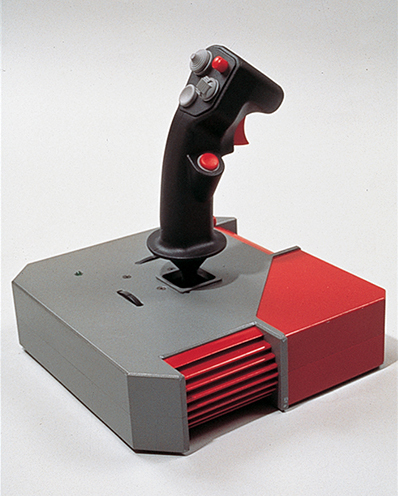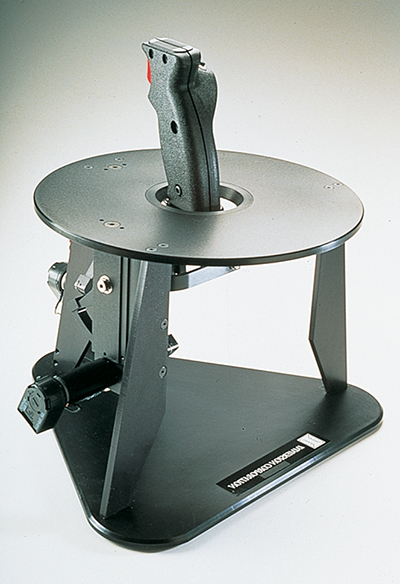Force Feedback Joystick
Any computer game joystick jockey will tell you: It's all in the touch. But a new technology called Force Feedback is adding vivid physical "feel" sensations to computer entertainment systems.
"Get a grip" takes on added dimension in the fast-paced, virtual world of computer gaming. Experience the recoil from shooting a gun in virtual reality. Perceive the jarring bounce, bump, and vibration while driving over simulated road terrain. Feel the reaction of your computerized dragster as it slams into the race track wall.
I-FORCE™ is a computer peripheral from Immersion Corporation of San Jose, California. This Silicon Valley -situated high-technology firm has taken interaction to a new dimension--one that literally comes alive in your hands.
I-FORCE was derived from virtual environment and human factors research and done at the Advanced Displays and Spatial Perception Laboratory at Ames Research Center, in collaboration with Stanford University's Center for Design Research.
Entrepreneur Louis Rosenberg, a former Stanford researcher, now president of Immersion Corporation, credits much of the knowledge acquired to move Force Feedback into the commercial world to the NASA-university joint research efforts. Rosenberg collaborated with Dr. Bernard Adelstein at Ames on studies of perception in virtual reality. Immersion Corporation adapted the basic qualities of Force Feedback: the crispness of initial contact, the hardness of surface rigidity, and the cleanness of final release, all in a virtual environment.
"It took us three years and much innovation, but Immersion can now produce consumer Force Feedback products," Rosenberg says. The result was an inexpensive way to incorporate motors and a sophisticated microprocessor into joysticks and other game controllers. These devices can emulate the feel of a car on the skid, a crashing plane, the bounce of a ball, compressed springs, or other physical phenomenon.
Immersion anticipates that the technology has the potential to increase the realism of the game environment and provide a more engaging and entertaining experience. By adding physical sensations to the toolbox of perceptual effects that game developers have at their disposal, Immersion contends that new life can be breathed into common video game paradigms. In essence, may the force be with you.
"Force Feedback will make the abstract world of software tangible, physical, and personal. It's not just visual any more!" exclaims promotional material from the company.
To run I-FORCE, Immersion developed a Force Feedback software protocol known as the I-FORCE API. The I -FORCE hardware and electronics architecture has been licensed to numerous manufacturers of computing peripherals. The first products incorporating the I-FORCE technology appeared in 1996. For example, CH-Products of Vista, California embodied the I-FORCE technology into their popular line of FlightStick and CombatStick controllers. Many more products from various vendors using I-Force are to follow as major hardware manufacturers have endorsed the Force Feedback concept.
Immersion's Rosenberg predicts that Force Feedback may go far beyond joysticks, such as a tool for handicapped people to escort unsteady hands or literally pushing open doors during a cyber-tour of a house for sale. Already, Immersion offers the Virtual Laparoscopic Interface™ that can hone the skills of a surgeon through realistic surgical simulations. In a similar fashion, the delicate nature of catheter-based procedures are also being targeted as an emerging simulation.
I-FORCE and Virtual Laparoscopic Interface are trademarks of Immersion Corporation.

Immersion Corporation has commercialized Force Feedback technology and added the sensation of feel to joysticks used in computer simulation games. NASA's work in advanced display technologies played a centerpiece in the concept.

An early Force Feedback prototype was derived from work done at NASA's Advanced Displays and Spatial Perception Laboratory.













